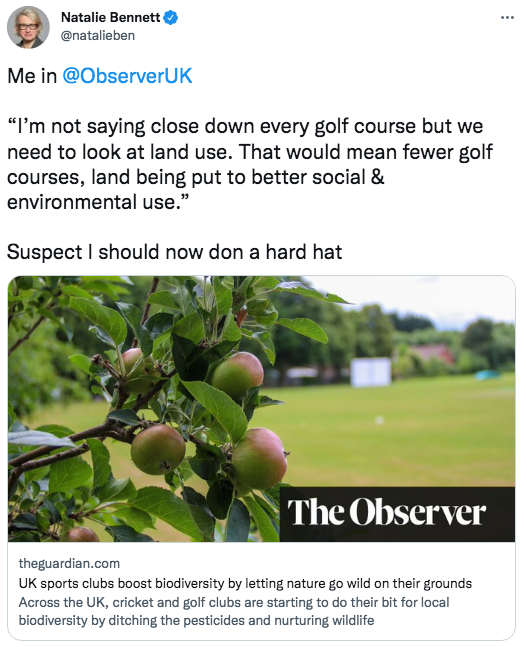Green Party peer calls for ‘fewer golf courses’
The Green Party life peer, Baroness Bennett of Manor Castle, has called for a reduction in the number of golf courses in the UK, despite being presented with evidence that many clubs are benefiting the environment.
Speaking to The Observer newspaper, the former leader of the Green Party was given examples of clubs increasing pollination and cleverly using rainwater for irrigation.
However, while no details are presented in the article to support her claim, she stated that golf courses destroy land. She also said that they should be ‘put to better use’, without specifying what that would be.
“The kind of [biodiverse-friendly] things they are doing are very small scale and you’ve still got fairways and greens that are a hugely destructive use of land,” she stated.
“I’m not saying close down every golf course in the country but I think we need to look at land use and that would mean, very clearly, fewer golf courses, and that land being put to better social and environmental use.”

The paper had stated that several golf clubs have installed starling nest boxes to encourage birds on to their courses because their slender beaks can grab leatherjackets without damaging the turf, whereas in the past the clubs would have used pesticides.
It also mentioned Newquay Golf Club, where an ecological rough management plan has seen wildflowers such as cranesbill, scabious and knapweed flourish and provide food for pollinators such as the dark green fritillary and six-spot burnet moth, and Weybrook Park Golf Club, near Basingstoke, which has introduced skylark protection areas, roped-off zones that members have been happy to give over to the ground-nesting bird.
Plus it stated that clubs are drilling boreholes and creating rainwater reservoirs to meet their irrigation needs, as well as growing more drought-tolerant types of grass.
It also cited the Scottish Wildlife Trust, which has been working with clubs and the golfing charity the FairWays Foundation, which is co-funding the Irvine to Girvan Nectar Network, a project to bring wildflower meadows back to the Ayrshire coast.
Network co-ordinator Lynne Bates is visiting clubs along the coast and supplying flower seeds that can help to create one continuous corridor, linking the courses with local nature reserves. The project is already making an impact, she says, with the return of the small blue to Ayrshire for the first time since the 1980s. Britain’s most diminutive butterfly needs kidney vetch for its caterpillars, and the plant is now abundant across many courses in Scotland and other coastal courses in the UK.
There have been numerous stories in recent years of golf courses implementing sustainability measures, but perhaps two studies show a better example of why golf can now be seen to be environmentally friendly.
Published on Phys.org, the scientists studied the biodiversity of green spaces in Melbourne for three years, comparing them to nearby public parks and residential areas.
‘The results surprised us,’ they wrote. ‘Golf courses contained the greatest diversity and abundance of beetles, bees, birds and bats of all the green spaces we studied. We found ground-nesting native bees that do not occur in much of the urban landscape because it is dominated by built surfaces and exotic flowering plants.
‘The minimum number of bird species we saw on a golf course was always higher than the maximum numbers at other green spaces. We found much more evidence of birds breeding. There was also a diverse array of insect-eating birds, which are in decline in many parts of Australia.

Baroness Bennett. Image from Twitter
‘Some golf courses supported all ten bat species known to occur in this part of metropolitan Melbourne. Bat activity was ten times greater than in nearby areas of housing. Golf courses also supported twice as many bat species considered ‘sensitive to urbanisation’.
Believed to be the biggest ever study conducted on the environmental impact that golf courses have on their communities, the USGA-funded Community Values of Golf Courses project saw researchers at the University of Minnesota and Michigan State University compare and contrast the golf courses with five other land uses: natural areas, city parks, suburban residential zones, urban residential zones and industrial parks.
The researchers demonstrated that properly managed golf courses provide the greatest amount of cooling among land uses, are more supportive of pollinators than urban residential or industrial areas and retain more nutrients from stormwater runoff than suburban or urban residential areas.
They concluded that the conversion of golf courses to residential or industrial use would sacrifice environmental value afforded to their local communities and could result in reduced biodiversity and even increased temperatures.















Baroness Bennett……. Phwoar
There is clearly a balance to the argument. Yes, building a golf course on a green space next to a densely populated area that restricts use for others would be unfair. The flip side is we have such an array of quality courses across the U.K. that individuals derive huge health & wellbeing benefits from! Golf clubs are beginning to address sustainability to secure their own futures with many role models out there. However, the real challenge golf faces is to improve access, transform diversity and inclusion and modernise……without this the sport has a bleak future
It is a gross misunderstanding as to how the industry is diversifying and providing a buffer against housing developers while doing a lot of good work to stimulate biodiversity. I’m a green supporter but this was a massive own goal.
Someone should remind Baroness Bennett about exercise golfers get, the social side, the courses that are a hive of activity for wildlife. Do we want to be concreted over? Anyone can have a go at golf, but few can afford a new house.
Absolutely ridiculous
She is only looking for confrontation to boost her low ratings
Why would golf courses be considered fair game but not grounds for football, rugby, croquet, tennis or cricket etc.?